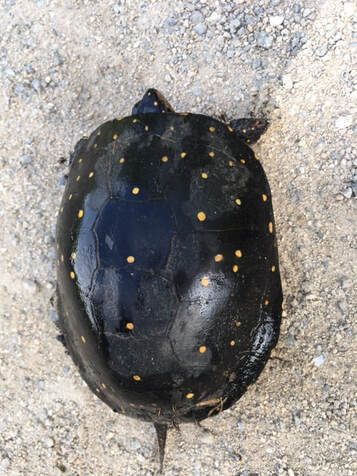
I never knew there was such a thing as a spotted turtle until I came across the little guy in the middle of our road. The sandy surface may have offered a comfortable spot to relax in the shade, but it wasn't safe. The way some frustrated wanna-be race drivers consider secondary roads as their private dirt track didn't bode well for me to leave the turtle where it was.
Astonishingly, it wasn't as shy as the common box or snapping turtles I generally see hanging out along the roadside. They usually retreat into their shells and allow me to pick them up and move them into the grass without any fuss.
Not this guy. He watched every move I made as I snapped pictures and complimented him on the nice paint job on his shell. When I reached down to pick him up, he refused to come quietly. Instead, the turtle gave me the evil eye as I grasped the sides of his shell. Then he squirmed out of my hands and ran away. That surprised me! Not the evil eye so much but the agility and speed at which he moved. He was quite fast.
I took the hint and didn't try a second time. Since the turtle didn't want to be carried, a few taps with my foot gently persuaded him to move to the shoulder. After the little guy disappeared amongst the overgrown vegetation bordering the ditch, I waved goodbye and continued on my way.
Later on, my research on Spotted Turtles yielded some very interesting information. "Spotted turtles are small, aquatic turtles, named for the yellow polka dots scattered across their dark shells. The species occur in wetlands throughout the east coast and in the Great Lakes region of the United States and is threatened by the loss, alteration, and fragmentation of this habitat. Climate change has the potential to impact the hydrology of the wetlands the species depends upon over time. Poaching and collection for the foreign and domestic pet trade also pose a threat for spotted turtle populations." (US Fish and Wildlife Service) https://www.fws.gov/species/spotted-turtle-clemmys-guttata
I wished I'd spent more time taking pictures of this threatened turtle. Wow! I feel privileged to have seen, talked to, and photographed a beautiful creature people rarely encounter.
I must admit, I'd never been a big fan of the deep ditches crisscrossing the local countryside mainly because they're prime mosquito-breeding territory. When I realized how many other creatures depend on the waterways though, I changed my way of thinking. Predatory insects such as dragonflies require the same wet, marshy conditions and eat the skeeters, as do the fish and frogs living in the ditches. We can't forget the herons and other waterfowl that drop by to feed on the insects, frogs, and fish.
That habitat is vital for turtles as well. They need clean, shallow bodies of standing or slow-flowing water with muddy or mucky bottoms and aquatic vegetation. At night and during hot weather, they burrow under vegetation or into the soil or muddy bottoms of the wetland or crawl into mammal burrows. They overwinter in shallow water, mud, mammal burrows, or lodges.
Even though they are aquatic, turtles, including the spotted variety, also spend time on land, especially during mating and nesting seasons. That's when they're more vulnerable to forces outside of nature, i.e., crossing paths with humans and our mechanized contraptions.
Conservation biologist James Gibb says, "Turtle populations in the Northeast, Southeast, and Great Lakes region suffer at least a 10 percent annual kill rate from road kills, and some of these regions likely have up to 20 percent mortality rates due to traffic encounters." Unfortunately, at those rates, turtle species are vanishing in some regions.
We've got to look out for these innocent creatures as they navigate across the terrain. They're clueless about roads and traffic. Please, keep an eye out for turtles (and other critters) while you're driving. Here are some tips for helping a turtle cross the road.
 RSS Feed
RSS Feed
